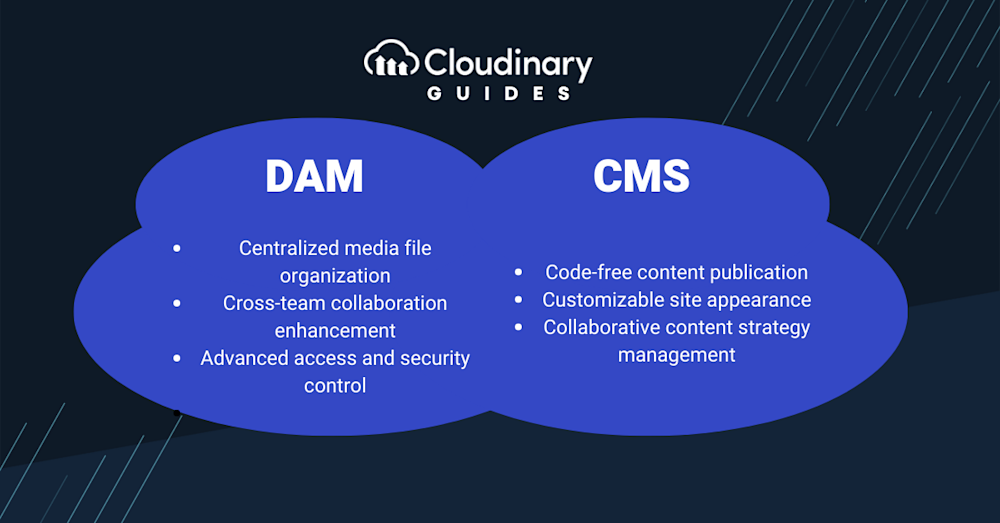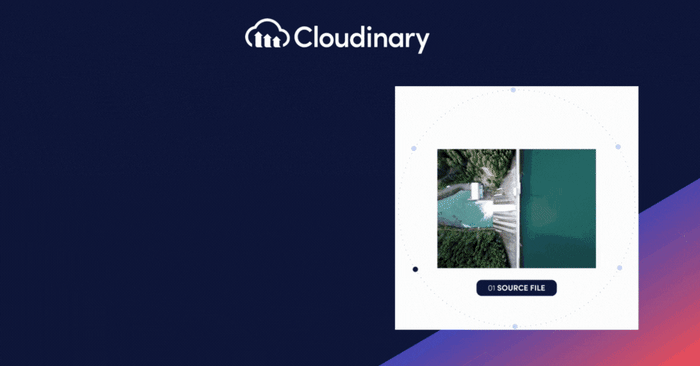Understanding the difference between Digital Asset Management (DAM) systems and Content Management Systems (CMS) is essential for any organization managing digital content at scale. A DAM system centralizes the storage, organization, and retrieval of rich media assets such as images, videos, and documents, offering advanced metadata, version control, and granular access rights.In contrast, a CMS is designed for creating, editing, and publishing web content like articles, pages, and blogs, featuring WYSIWYG editors, template management, and workflow tools for content teams.
While a CMS powers the content and structure of websites, a DAM ensures that all digital assets are efficiently managed and accessible. Modern businesses often integrate both systems to streamline the entire content lifecycle, using the DAM to store and organize assets, and the CMS to publish them across digital channels.
In this article:
- What Is a DAM
- Key Benefits of Using DAM
- Examples of a DAM
- What Is a CMS
- Key Benefits of a CMS
- Examples of a CMS
- Differences between DAM vs CMS
- How DAM and CMS Work Together
- The Integration of DAM and CMS
- When You Need Both
- Optimize with Cloudinary
What Is a DAM
A Digital Asset Management (DAM) system is a central repository that allows you to store, organize, and retrieve rich media and manage digital rights and permissions. Digital Asset Management is essentially your digital library’s librarian. It’s a system designed to store, organize, and retrieve media files like photos, videos, audio files, and PDF documents.
Unlike a simple storage solution, DAM has tools for tagging, categorizing, and managing rights and permissions. This isn’t just about keeping your files in neat folders but creating a searchable, accessible, and secure repository of your digital assets. Using a DAM effectively can significantly speed up content retrieval and deployment, which is essential in fast-paced development environments.
Key Features and Use Cases of DAM
- Purpose: Store, organize, manage, and distribute digital media assets like images, videos, logos, and documents.
- Key Features: Advanced metadata and tagging, version control, granular access rights, and powerful search capabilities based on file characteristics.
- Use Cases: Marketing and branding, e-commerce, internal communications, and creative workflows.
- Who Uses It: Marketing teams, creative teams, agencies, and e-commerce businesses.
Key Benefits of Using a DAM
One of the main advantages of using a DAM system is its ability to save you time. Imagine you’re working on a project that requires a specific video clip you know you have somewhere. Without a DAM, you might end up sifting through folders for hours. With a DAM, a quick search using tags or categories brings up the clip in seconds.
DAM systems also enhance collaboration across teams. By centralizing assets, everyone from marketing to product development can access the latest, approved versions of digital content. This reduces the risk of using outdated or off-brand assets, ensuring consistency across your projects.
In addition, DAM systems offer robust security features. They allow you to control who has access to what, protecting sensitive assets. This level of control is crucial for organizations that manage a large volume of digital content, mainly when it includes copyrighted or proprietary information.
Examples of DAMs
Multiple platforms stand out for their robust features, user-friendliness, and efficiency in managing a wide array of digital assets. These platforms cater to various industries, offering scalable solutions for businesses ranging from small startups to large enterprises.
- Cloudinary – Renowned for its powerful cloud-based image and video management services, Cloudinary excels in automating the optimization, transformation, and delivery of visual content. Developers favor its straightforward integration into applications and websites, making it indispensable in media-rich projects.
- Adobe Experience Manager Assets – Part of the Adobe Experience Cloud, this high-end solution offers comprehensive tools for asset management, including AI-powered tagging and smart cropping, designed for enhancing team collaboration and brand consistency across channels.
- Bynder – Best known for its intuitive user interface, Bynder provides an effective way to create, find, and use content focusing on brand consistency. It also offers workflow modules to streamline approval processes, making it ideal for marketing and creative teams.
- Widen Collective – This platform combines asset management with brand management capabilities, ensuring assets are well-organized and aligned with brand guidelines. It’s valued for its flexibility and ease of use in managing content across its lifecycle.
What Is a CMS
A Content Management System is the backbone of your website and blog, enabling you to create, manage, and publish content without using code. It’s a software application designed to help users create, manage, and modify website content without specialized technical knowledge. In essence, a CMS provides the foundation for building your website, allowing you to focus on the more creative aspects of content creation rather than the backend coding.
The beauty of a CMS lies in its simplicity and accessibility. It democratizes content creation, allowing content creators, marketers, and developers to contribute and modify content efficiently. For developers and technical professionals, a CMS simplifies website management and enables a scalable approach to web development and content strategy. Whether working on a personal blog, a complex e-commerce site, or anything in between, a CMS can adapt to your needs.
Key Features and Use Cases of CMS
- Purpose: Create, edit, manage, and publish website content such as articles, blog posts, and web pages.
- Key Features: “What You See Is What You Get” (WYSIWYG) editors, template management, workflow management for content creation, and design management.
- Use Cases: Corporate websites, e-commerce websites, blogs, and online publications.
- Who Uses It: Content writers, web managers, designers, and business owners.
Key Benefits of a CMS
The primary advantage of using a CMS is its ability to streamline the content creation and publication. With a CMS, you don´t need to write code to post a new blog article or update a product page. This means your team can focus more on creating quality content and less on the mechanics of getting that content live.
Moreover, a CMS offers flexibility in content management. Most CMS platforms come with a range of templates and plugins, allowing you to customize the look and feel of your site and add new features as needed. This adaptability makes keeping your website fresh and aligned with your brand’s evolving needs easier.
Another significant benefit is the collaborative environment a CMS fosters. With key features like multi-user access and content scheduling, a CMS makes it easy for teams to work together on content projects, regardless of their physical location. This collaborative approach speeds up the content creation process and ensures a cohesive content strategy.
Examples of a CMS
Several CMSs have made a significant impact and have been praised for their ability to empower users with varying degrees of technical prowess to build and maintain dynamic websites. Here are some prime examples that have become staples in the industry:
- WordPress – A powerhouse that drives a substantial portion of the web; it’s known for its immense plugin ecosystem and themes that cater to virtually any website requirement.
- Joomla – Offers a balance between user-friendliness and robust functionality, making it ideal for e-commerce and social networking websites.
- Drupal – Stands out for its high level of customizability and a strong community, preferred for complex, resource-intensive sites requiring detailed user management.
- Squarespace – Shines with its design-forward approach and intuitive drag-and-drop interface, perfect for creatives looking to build visually appealing sites without diving into code.
Each CMS has its unique toolkit, community, and capabilities, allowing developers and content creators to select a platform that best aligns with their project’s goals and technical expertise.
Differences between DAM vs CMS
The primary difference between DAM vs CMS lies in their core focus and functionality. A Digital Asset Management system is specialized in managing digital assets such as images, videos, and documents. They excel in organizing, tagging, and distributing these assets across various channels and platforms. On the other hand, a CMS platform is designed to manage and publish content like articles, blogs, and web pages. It provides tools for creating, editing, and managing website content, often incorporating digital assets managed by a DAM.
Another key difference is in their user base. DAM systems are typically used by marketing teams, creative professionals, and digital asset managers who require robust asset storage, retrieval, and optimization solutions. CMS platforms cater to a broader audience, including content creators, web admins, and marketers who need to update website content regularly without delving into the complexities of web development.
DAM systems offer advanced features for asset management, such as version control, rights management, and detailed metadata tagging. While CMS platforms may offer basic media asset management capabilities, they primarily focus on content creation, workflow management, and website customization.
How DAM and CMS Work Together
- Integrated Workflow: A DAM and CMS can integrate to create a seamless workflow. The DAM stores and organizes assets, while the CMS pulls and uses these assets for publishing on websites and other channels.
- Improved Efficiency: This integration prevents duplicate content and ensures brand consistency across all digital properties.
- Centralized Control: Users can access and use assets from the DAM directly within the CMS, streamlining the process of content creation and publishing.
The Integration of DAM and CMS
Integrating DAM with CMS bridges the gap between managing digital assets and publishing content, creating a seamless workflow from asset creation to content publication. This integration allows users to access and utilize digital assets stored in the DAM directly within the CMS environment, streamlining the content creation process.
For developers and content creators, this means no more switching between systems to find and insert media into web pages or articles. With integration, digital assets are readily available within the CMS, with the latest versions and metadata. This saves time and ensures consistency and accuracy in how assets are used across all digital platforms.
When You Need Both
Sometimes, using both a DAM system and a CMS is the best way to handle video hosting and delivery at scale. Consider using both when:
- You manage large libraries of videos and images that need consistent organization, versioning, and access control across teams.
- You want to automate video transformations, such as resizing, optimizing, or converting formats, before publishing to your CMS.
- You produce content across multiple channels and need a single source of truth for media while still customizing how it appears on your site.
- You rely on analytics to understand media performance and want those insights connected directly to your publishing workflow.
- You aim to speed up your media delivery with optimized assets that load fast and look sharp on every device.
Optimize with Cloudinary
Cloudinary takes this integration a step further by offering an advanced solution combining DAM and CMS’s strengths. It provides a cloud-based platform where digital assets are stored, managed, and automatically optimized for different channels and devices. This means that images and videos are delivered in the most efficient format, size, and resolution, enhancing user experience while reducing loading times and bandwidth usage.
For developers, Cloudinary offers a suite of APIs and SDKs, making it easy to integrate these optimization features directly into your CMS, custom applications, or websites. TCloudinary even offers a powerful WordPress plugin out-of-the-box. This integration ensures that all digital content, whether managed through a CMS or stored in a DAM, is optimized for performance and quality.
Additionally, Cloudinary’s AI-driven capabilities automate many aspects of digital asset management, such as tagging and categorization, further simplifying the workflow for developers and content managers. By using Cloudinary, you can ensure that your digital assets are well-organized, accessible, and optimized for every user interaction, making your content strategy more effective and efficient.
Final Thoughts
While DAM and CMS serve different purposes in the digital content management ecosystem, their integration, especially when optimized with solutions like Cloudinary, can significantly enhance content delivery and user experience. Understanding the strengths and applications of each system allows developers and content creators to make informed decisions, ensuring that digital content is managed efficiently and delivered in the best possible way.
Transform your digital asset management with Cloudinary’s seamless image and video optimization. Sign up for free today!



